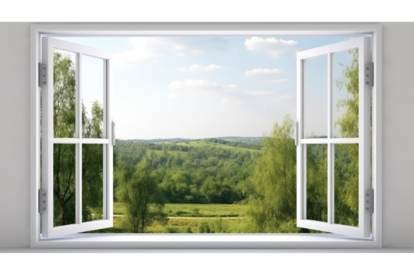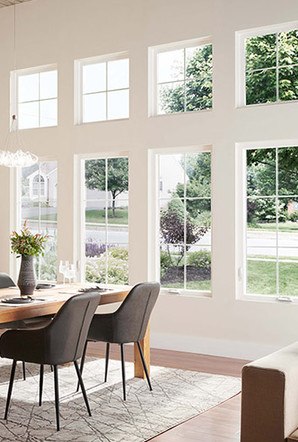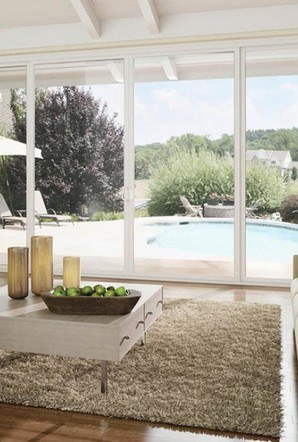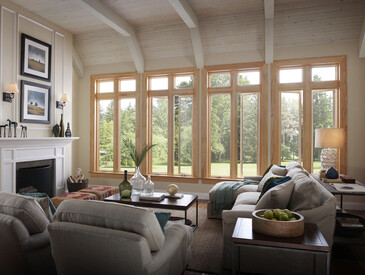Whether you’re in the market for a new home or renovating your current one, windows will eventually make their way to your home improvement to-do list. While it’s easy to get lost in details like size, style, or glass type, don’t overlook the most important contributor to a window’s functionality: the window frame.
This article covers everything you need to know about window frames. From material choices to durability, energy-efficiency, and cost factors, we’ll draw the curtain on the most essential features to consider, and help you navigate this big decision with confidence.
What Is a Window Frame?
Before diving into form and function, let’s start with the basics. A window frame is the structural enclosure that surrounds and supports the entire window system. It’s what holds the glass pane in place, providing structural integrity to the wall opening and ensuring insulation. More than just aesthetically pleasing, window frames play a key role in your window’s energy efficiency and longevity, and the overall comfort of your home.
When Is It Time to Replace Your Windows?
Window replacement is a big undertaking, so it’s only natural that you find yourself making every effort to extend the shelf-life of your windows. Here are some surefire signs it’s time to replace your windows:
- Drafts or water seepage around your windows can hike up energy costs and risk water damage.
- Excessive energy bills may point to inefficient windows that let conditioned air escape, forcing your HVAC system to work harder than it should.
- Difficulty opening or closing your windows may signal issues like warped materials or rusted frames, compromising functionality and safety.
- Soft or chipped window frames are a red flag for water infiltration and rot, and may lead to mold growth or structural damage.
If you do opt to replace your windows, proper installation is key. Even the most expensive window frames won’t perform effectively if they’re not installed well. Pre-installation waterproofing and properly sealing window frames from the inside should be done meticulously in order to avoid leakage, drafts, and a range of other long-term problems.
Window Frame Materials: Finding the Perfect Fit
Your choice of window frame impacts aesthetics and functionality. When it comes to appearance, window frames play a key role in defining your home’s unique style, while adding color accents and enhancing curb appeal. The material you choose directly influences these factors, including cost, durability, energy efficiency, and maintenance.
The good news is, there’s a wide variety of options to choose from. Whether it’s aluminum, vinyl, or fiberglass, each material brings its own set of benefits and distinctive features. Let’s shed some light on the preferred choices in today’s market.
Vinyl Window Frames
Vinyl window frames reign supreme when it comes to quality, affordability, and cost-effectiveness, making them one of the most popular options among budget-savvy homeowners. Made from polyvinyl chloride (PVC), they offer great insulation and are moisture-resistant, which means they’re ideal for humid environments. They’re also extremely durable, fire-resistant, and virtually maintenance-free.
Over time, vinyl may expand and contract when exposed to changing temperatures, causing the frames to crack. Going with a quality manufacturer of vinyl frames is therefore key. MILGARD, for example, uses high-quality titanium dioxide and stabilizers to improve the efficiency and performance of our vinyl frames, and offers finishes that allow UV rays to pass through color and reflect off the frame, preserving longevity.
Aluminum Window Frames
Aluminum window frames are lightweight and strong, providing plenty of support for larger window panes. They’re also an affordable option, making them a great choice if you’re on a budget but still want quality.
Aluminum naturally conducts cold and heat, so these frames have a reputation as being less eco-friendly than their counterparts. MILGARD has addressed this with proprietary, thermally-improved aluminum that enhances the energy efficiency of their aluminum windows. In addition, aluminum frames are long-lasting, aesthetic, and extremely low-maintenance.
Fiberglass Window Frames
Fiberglass window frames, made from a blend of resin and glass fibers, are among the strongest frames available. These frames are thinner than others, so they’re especially suitable for thick glass and noise reduction. Fiberglass places in the middle to high price range, though their longevity makes a good case for the high initial investment.
The low thermal conductivity of fiberglass also means they won’t expand or contract, so they’re highly energy-efficient and durable. MILGARD’s fiberglass windows are resistant to warping, swelling, and rotting, making them ideal for homes in wet regions.
New Construction vs. Replacement Window Frames: What’s the Difference?
When installing windows, there are two options: new construction and replacement windows. Simply put, new construction window frames feature additional components designed to attach them directly to a wall’s exposed wooden frame, whereas replacement window frames (also called retrofit windows) are installed into existing window openings and therefore don’t have these components.
The Right Choice for Your Project
The choice between new construction vs. replacement windows is pretty clear-cut. If you’re building a new home, new construction window frames are what you’re looking for. If you’re upgrading existing windows, replacement window frames are the most cost-efficient way to go.
New construction windows are also worth considering if you find yourself knee-deep in a major renovation that involves stripping walls down to their studs. You’ll gain enhanced energy efficiency and weatherproofing, and may also be able to customize your new windows to your liking.
Pros and Cons
Replacement window frames are quicker and relatively painless to install. They’re less expensive, enabling you to improve your home’s energy efficiency without breaking the bank. Yet replacement frames have to match the size and shape of your previous window down to a tee, since poorly fitted replacements can lead to long-term problems.
New construction window frames offer customizable options and significantly improve weatherproofing and energy efficiency. MILGARD custom designs each window to your home’s exact specifications, so you can get creative in the sizing and shaping of your windows. However, unless you’re constructing an entirely new home, installing new construction frames can be disruptive and labor-intensive (as you’ll need to remove trim and siding down to the studs).

Can You Paint Window Frames?
If you aren’t quite ready to take the plunge, you may be considering a fresh coat of paint to revive your worn-out frames and postpone their replacement. Indeed, a common question among homeowners is whether you can paint old window frames. The answer is yes, although, truth be told, it’s not always recommended.
In the case of vinyl frames, many paint professionals advise against it. The paint won’t last as long as the vinyl finish, and will eventually chip and flake. In addition, you run the risk of cracking the surface when you repaint vinyl windows. Lastly, painting vinyl often voids your warranty.
If you do choose to give your frames a paint job, vinyl or not, choose the right type of paint and apply the recommended prep techniques to ensure a long-lasting finish. This may involve sanding and priming to promote adhesion and prevent peeling, or using specialized paints formulated for specific materials.
Whether you’re looking to restore antique window frames or give contemporary frames a makeover, it’s always a good idea to consult with a painting professional before you proceed, to ensure the best possible outcome for your project.
How to Choose the Perfect Window Frames for Your Home
Selecting the ideal window frames for your home involves a careful balance of factors ranging from budget considerations to style and efficiency. Here are some tips to consider.
Determine Your Budget
When it comes to window frames, the general rule of thumb is to aim for the highest quality within your budget. Before you begin shopping, identify your financial priorities and consider how to best allocate your budget. With so many options on the market, scouting out the most efficient frame materials to help meet your financial goals is a good idea.
Consider Your Home’s Architectural Style
Whether your home boasts a modern, traditional, or contemporary architectural style, choosing window frames that harmonize with its aesthetic can significantly elevate its visual appeal. Take, for instance, the elegance of bay windows on Victorian-era homes or the charm of casement windows on ranch-style houses; these choices contribute to a cohesive architectural theme.
Another element that reflects architectural style is color accent, easily achieved through window frames. Consider the rising popularity of modern houses with black window frames, enhancing their minimalist and sleek look. Black window frames are also common in farmhouse-style homes, offering a striking contrast to their white exterior.
Don’t Underestimate Energy Efficiency
As an energy-conscious homeowner, you’ll want to minimize the costs of heating and cooling your home, with window frames that maximize energy efficiency as well as overall comfort. Whether you’re purchasing new construction windows for a home in progress, or replacement window frames for existing windows, the key is determining which type of window will give you the best long-term value for your investment.
Find Your Perfect Window Frames
Choosing the perfect window frames for your home can be overwhelming. Whether you’re looking to purchase new construction or replacement windows made from vinyl, aluminum, or fiberglass, MILGARD is here to guide you every step of the way.
With our exclusive planning and visualizer tools, we help eliminate the guesswork from your decision-making process. Contact us today or find a local certified Milgard/MI dealer in your area to learn more about our intuitive designs, high-quality materials, and expert installation.





































